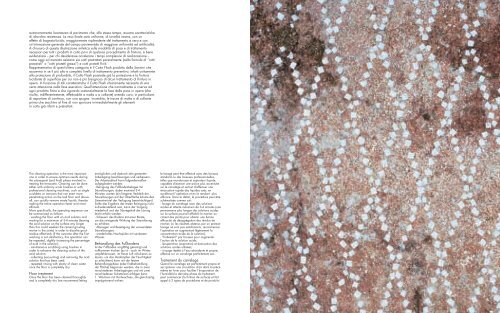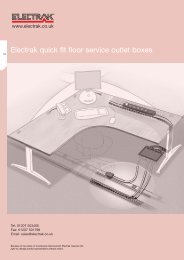by Stone & Sannini - EKA Group
by Stone & Sannini - EKA Group
by Stone & Sannini - EKA Group
Create successful ePaper yourself
Turn your PDF publications into a flip-book with our unique Google optimized e-Paper software.
autonomamente lucentezza al pavimento che, allo stesso tempo, assume caratteristiche<br />
di idro-oleo resistenza. La resa finale sarà uniforme, di tonalità neutra, con un<br />
effetto di bagnato-lucido, maggiormente risplendente del trattamento a cera e con<br />
un’intonazione generale del campo pavimentale di maggiore uniformità ed artificialità.<br />
A chiusura di questa illustrazione sintetica sulle modalità di posa e di trattamento<br />
necessari per tutti i prodotti in cotto privi di qualsiasi procedimento di finitura, è bene<br />
evidenziare -- per chi desiderasse accelerare i tempi complessivi di realizzazione --<br />
come oggi sul mercato esistano sia cotti pretrattati parzialmente (nella formula di ”cotti<br />
precerati” o ”cotti protetti grezzi”) e cotti protetti finiti.<br />
Rappresentativo di quest’ultima categoria è il Cotto Flash prodotto dalla <strong>Sannini</strong> che<br />
assomma in se il più alto e completo livello di trattamento preventivo; infatti unitamente<br />
alla protezione di profondità, il Cotto Flash possiede già la protezione e la finitura<br />
lucidante di superficie per cui non è più bisognoso di alcun trattamento di finitura in<br />
opera. In funzione di tali caratteristiche il Cotto Flash chiaramente necessita di una<br />
certa attenzione nella fase esecutiva. Quell’attenzione che normalmente si riserva ad<br />
ogni prodotto finito e che riguarda sostanzialmente la fase della posa in opera (che<br />
risulta, indifferentemente, effettuabile a malta o a collante) avendo cura, in particolare,<br />
di asportare di continuo, con una spugna inumidita, le tracce di malta o di collante<br />
prima che secchino al fine di non sporcare irrimediabilmente gli elementi<br />
in cotto già rifiniti e pretrattati.<br />
The cleaning operation is the most important<br />
one in order to ensure optimum results during<br />
the subsequent (and final) phase involved in<br />
treating the terracotta. Cleaning can be done<br />
either with ordinary scrub brushes or with<br />
professional cleaning machines, such as single<br />
scrubbers or wet-vacs that can exert more<br />
penetrating action on the laid floor and above<br />
all, can quickly remove waste liquids, there<strong>by</strong><br />
making the entire operation faster and more<br />
efficient.<br />
More specifically, the operating sequence can<br />
be summarized as follows:<br />
- washing the floor with an acid solution and<br />
waiting for a maximum of 3-4 minutes (leaving<br />
the acid solution on the surface any longer<br />
than this could weaken the cement grouting<br />
mortar in the joints) in order to dissolve grout<br />
residue effectively (if the outcome after the first<br />
washing is not satisfactory, this operation can<br />
be repeated, slightly increasing the percentage<br />
of acid in the solution);<br />
- simultaneous scrubbing using brushes in<br />
order to enhance the cleaning action of the<br />
acid solution;<br />
- collecting (vacuuming) and removing the acid<br />
solution that has been used;<br />
- repeated rinsing with plenty of clean water<br />
once the floor is completely dry.<br />
Floor treatment<br />
Once the floor has been cleaned thoroughly<br />
and is completely dry (we recommend letting<br />
ermöglichen und dadurch den gesamten<br />
Arbeitsgang beschleunigen und verbessern.<br />
Der Arbeitsablauf kann folgendermaßen<br />
aufgegliedert werden:<br />
- Reinigung des Fußbodenbelages mit<br />
Säurelösungen, dabei maximal 3-4<br />
Minuten warten (ein längerer Verbleib der<br />
Säurelösungen auf der Oberfläche könnte den<br />
Zementmörtel der Verfugung beeinträchtigen).<br />
Sollte das Ergebnis der ersten Reinigung nicht<br />
zufriedenstellend sein, kann der Vorgang<br />
wiederholt und der Säuregehalt der Lösung<br />
leicht erhöht werden.<br />
- Scheuern des Bodens mit einer Bürste,<br />
um die reinigende Wirkung der Säurelösung<br />
zu erhöhen;<br />
- Absaugen und Beseitigung der verwendeten<br />
Säurelösungen;<br />
- wiederholtes Nachspülen mit sauberem<br />
Wasser.<br />
Behandlung des Fußbodens<br />
Ist der Fußboden sorgfältig gereinigt und<br />
vollkommen trocken (es ist - auch im Winter<br />
-empfehlenswert, im Raum Luft zirkulieren zu<br />
lassen, um das Verdampfen der Feuchtigkeit<br />
zu erleichtern) kann mit der letzten<br />
Behandlungsphase (oder Endbehandlung<br />
der Fläche) begonnen werden, die in zwei<br />
verschiedenen Arbeitsgängen und mit zwei<br />
verschiedenen Substanzen erfolgen kann:<br />
1. Wachsen mit Hartwachsen, die gleichzeitig<br />
imprägnierend wirken;<br />
le lavage peut être effectué avec des brosses<br />
standard ou des laveuses professionnelles,<br />
telles que monobrosse et aspirateur liquide,<br />
capables d’exercer une action plus accentuée<br />
sur le carrelage et surtout d’effectuer une<br />
évacuation rapide des liquides usés, en<br />
accélérant l’opération et en la rendant plus<br />
efficace. Dans le détail, la procédure peut être<br />
schématisée comme suit:<br />
- lavage du carrelage avec des solutions<br />
acides et attente maximum de 3-4 minutes (une<br />
permanence plus longue des solutions acides<br />
sur la surface pourrait affaiblir le mortier au<br />
ciment des joints) pour obtenir une bonne<br />
efficacité de désagrégation des résidus de<br />
mortier; (si les résultats obtenus par un premier<br />
lavage ne sont pas satisfaisants, recommencer<br />
l’opération en augmentant légèrement la<br />
concentration acide de la solution);<br />
- ”frottement” par brosses pour augmenter<br />
l’action de la solution acide;<br />
- récupération (aspiration) et évacuation des<br />
solutions acides utilisées;<br />
-- rinçage répété à l’eau abondante et propre,<br />
effectué sur un carrelage parfaitement sec.<br />
Traitement du carrelage<br />
Quand le carrelage est parfaitement propre et<br />
sec (prévoir une circulation d’air dans la pièce<br />
même en hiver pour faciliter l’évaporation de<br />
l’humidité) la dernière phase du traitement<br />
peut commencer (la finition de surface) et fait<br />
appel à 2 types de procédures et de produits:<br />
245





